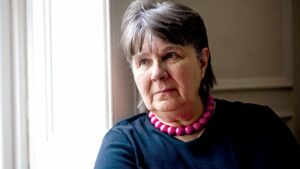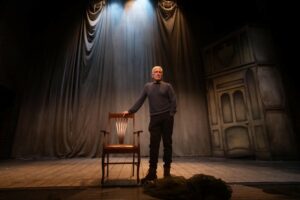John Waters doesn’t believe in ghosts, yet he’s been seeing one most nights for the last four months. That’s because the veteran of Australian screens, theatres and concert stages is starring in the dramatisation of Susan Hill’s spooky novel, The Woman in Black, the titular character of which is a particularly tenacious ghost.
Hill has made the interesting observation that being scared by stories is a way we learn to manage our fears, and Waters is inclined to agree. “I have enjoyed scary things in the past,” he says, “and supernatural things, in particular, have always been very intriguing. I think the vast majority of us don’t really believe in ghosts, per se, but there’s enough of a window of our imagination left open to say, ‘Well, there could be something.’ We like to leave that window open, and then when we go out of these stories into our actual lives, we think, ‘Oh, phew, I’m actually a bit more secure than that. I don’t think those things are real, and so I can handle real life.’ Perhaps there’s that about it.”

Unlike her English-born son, Waters’ mother was adamant she did see a ghost. The family was living on the English Channel island of Alderney, where a renovated old fort was inhabited by friends of his mother. “She was down on the beach,” he recounts, “and saw a lady in a window of the house, and thought, ‘Who’s that? Must be the cleaning lady.’ She went to the one door that led up to this turret where the room was, and it was open. So she went inside, and the window was open, but there was no one there. She thought, ‘Well, that’s odd, because I would’ve seen her leave.’ She related this to her friend, and her friend said, ‘Oh, well, they do say there’s a lady who used to live here, and she stands in that window looking out to sea, waiting for her husband to return. He was lost at sea.’ Mum maintained that she’d seen this ghost all her life.”
Attempts to evoke the supernatural on stage have often been more ludicrous than unnerving. To avoid that, playwright Stephen Mallatratt framed Hill’s novel, already a story-within-a-story, inside another layer of narrative, with the protagonist, Kipps, consulting a professional actor on how to tell his family the story that’s haunted him for 30 years. To bring the tale to life, that actor (played by Daniel MacPherson) becomes Kipps, and he has Kipps (Waters) become the Actor, performing all the other roles – except the ghost. (By convention, the person playing the ghost remains anonymous.)
“We’re asking the audience to imagine an empty theatre with two men workshopping this play,” Waters explains. “It’s a unique way of telling the story, and it’s a very clever adaptation.” He contrasts this with James Watkins’ 2012 film, starring Daniel Radcliffe, which just zeroed in on the supernatural elements. “The stage experience is so much more interesting,” he says. “It does what the film can’t do: it involves two actors urging the audience to come on this journey with them, a large part of which is in their imagination.
“We are switching in and out of our roles in the play back to our roles as the older man and the young actor to talk about it, and then back into the play. When it’s done properly, I think it’s a fantastic piece of writing and a great challenge for two actors. The interplay between the two men is interesting in itself, because it’s something that happens apart from the actual story…

“It’s billed as being a very scary experience,” he continues, “which it is in parts, but it’s also a study of two men and a relationship that develops over the course of the play. Arthur Kipps starts as a terribly shattered and traumatised man, and the young actor is brash and bold, and we see them change. The therapy is working on the older man, and he becomes energised. The young actor has been cast in the role of the Kipps of 30 years previously, and it begins to weigh on him. So we see two polar-opposite men at the start, and their relationship and friendship develop, all the while telling this rather creepy story.”
Waters relished the challenge of finding different voices and physicalities for each of his half-dozen characters, including the complex role of the older Kipps at the outset of the play. “I have to portray a very shattered man,” says Waters, “and yet I don’t want to appear pathetic. I want to appear, in fact, brave because he’s shattered. He’s trying to deal with the memory that way.”
Walters played the same role 18 years ago – so long that he had to relearn the lines from scratch, and with the parts being so substantial, he and MacPherson worked together via Zoom to get a head-start before rehearsals began. This time the show was directed by Anthony Eden, while last time Waters had the show’s original director Robin Herford, who’d commissioned the play from Mallatratt in 1987. Conceived as a cheap, Christmastime filler, it ended up running for over 13,000 performances in the West End, a record beaten only by The Mousetrap.
The current production, which has already toured seven Australian cities, is Waters’ first play since he was the lead in Jonathan Biggins’ Talk (about a shock jock) for Sydney Theatre Company in 2017. Meanwhile, he’s had work on screen and in musicals, as well as regularly reviving his John Lennon tribute show, Looking Through a Glass Onion. But he loves returning to straight theatre. “It’s exciting,” he says. “And stepping out on a stage in front of a thousand people is a confronting thing to do, whether you are going to sing a bunch of songs and talk to an audience or do a play.”
Ghost, or no ghost.
The Woman in Black: Theatre Royal, July 30-August 17.